#Paul Cartwright
Explore tagged Tumblr posts
Text
youtube
1 note
·
View note
Text
Yo! That's My Jawn: The Podcast - Ep. 5.4 - Craig Wedren
In this episode, Nate delights in the latest dance album trend and invokes the spirit of Ren McCormack before sitting down for a chat with Craig Wedren. They talk about the Middle Aged Dad Jam Band, heart health, Craig’s heart attack in 2018, the pandemic, growing up in Cleveland, how his core friend group has survived throughout the years personally and creatively, introducing new people into…
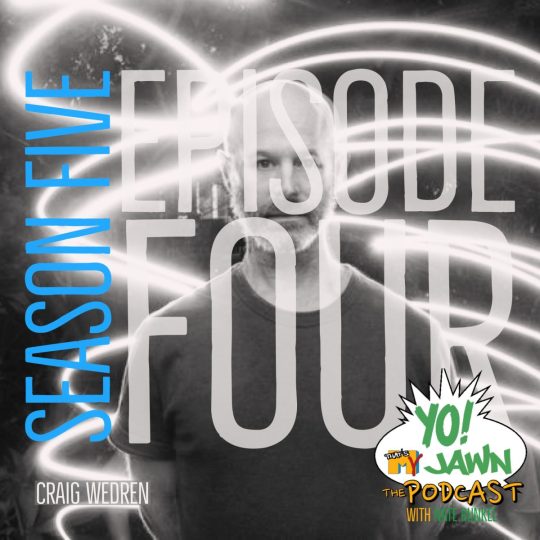
View On WordPress
#Anna Waronker#coronavirus#COVID#Craig Wedren#david wain#First Love Last Rights#interview#jawn#jeff buckley#John Doe#music#Nate Runkel#Paul Cartwright#philly#podcast#the State
0 notes
Text

FASHION CREDITS: LADY GAGA AT COACHELLA WEEKEND I
Eight years after she first made history at Coachella, Lady Gaga reclaimed her throne in 2025 with a headlining performance that was nothing short of operatic chaos.
Choreography by Parris Goebel, styling by HARDSTYLE, hair by Frederic Aspiras and glam by Sarah Tanno-Stewart.
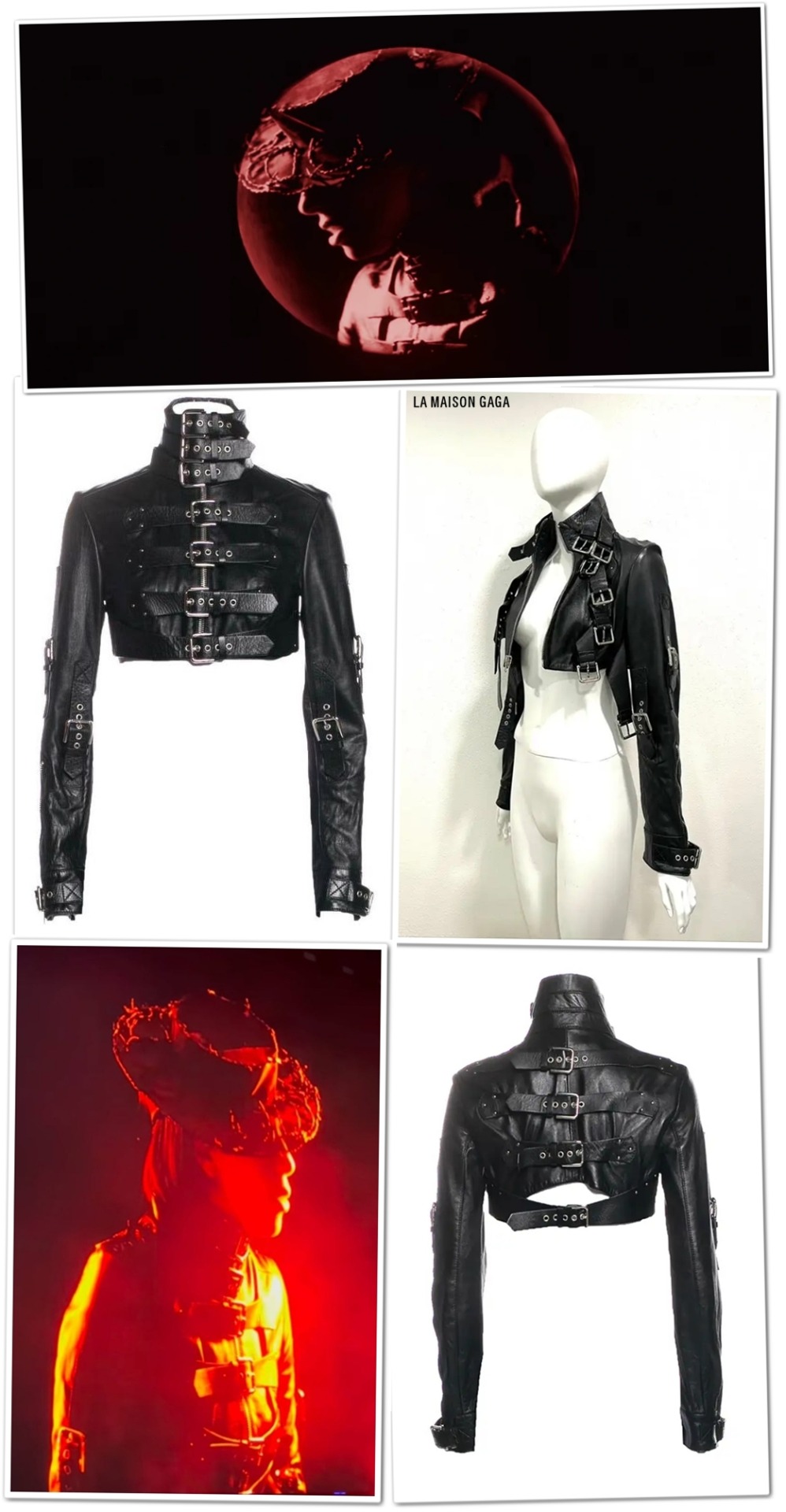
Her dark pop spectacle opened with a haunting visual interlude titled “The Manifesto of Mayhem”—a cinematic overture that reintroduced the world to Mistress Mayhem, Gaga’s latest alter ego.
Bathed in crimson light and surrounded by shadows, Gaga emerged on the screens in a rare archival piece: a bondage-inspired black leather straitjacket from Dolce & Gabbana’s Spring/Summer 2003 collection. The jacket, adorned with a grid of heavy buckles and silver hardware, set the tone for the night—iconoclastic, provocative, and entirely in control.

The incredible black mesh boater hat with rubber barbed wire around was created for our girl by milliner Lara Jensen who‘s been working with Gaga for over a decade!

Her angelic counterpart donned the Garden Fairy mesh corset top made from recycled vintage fabrics ($925 - sold out) from Central Saint Martins graduate Gyouree Kim‘s Spring/Summer 2025 "Cherubim" collection.
If the "Manifesto of Mayhem" set the tone, then what followed was pure operatic excess. Gaga made her true entrance atop a towering crimson structure draped in velvet folds—her silhouette like a deity descending upon her disciples.
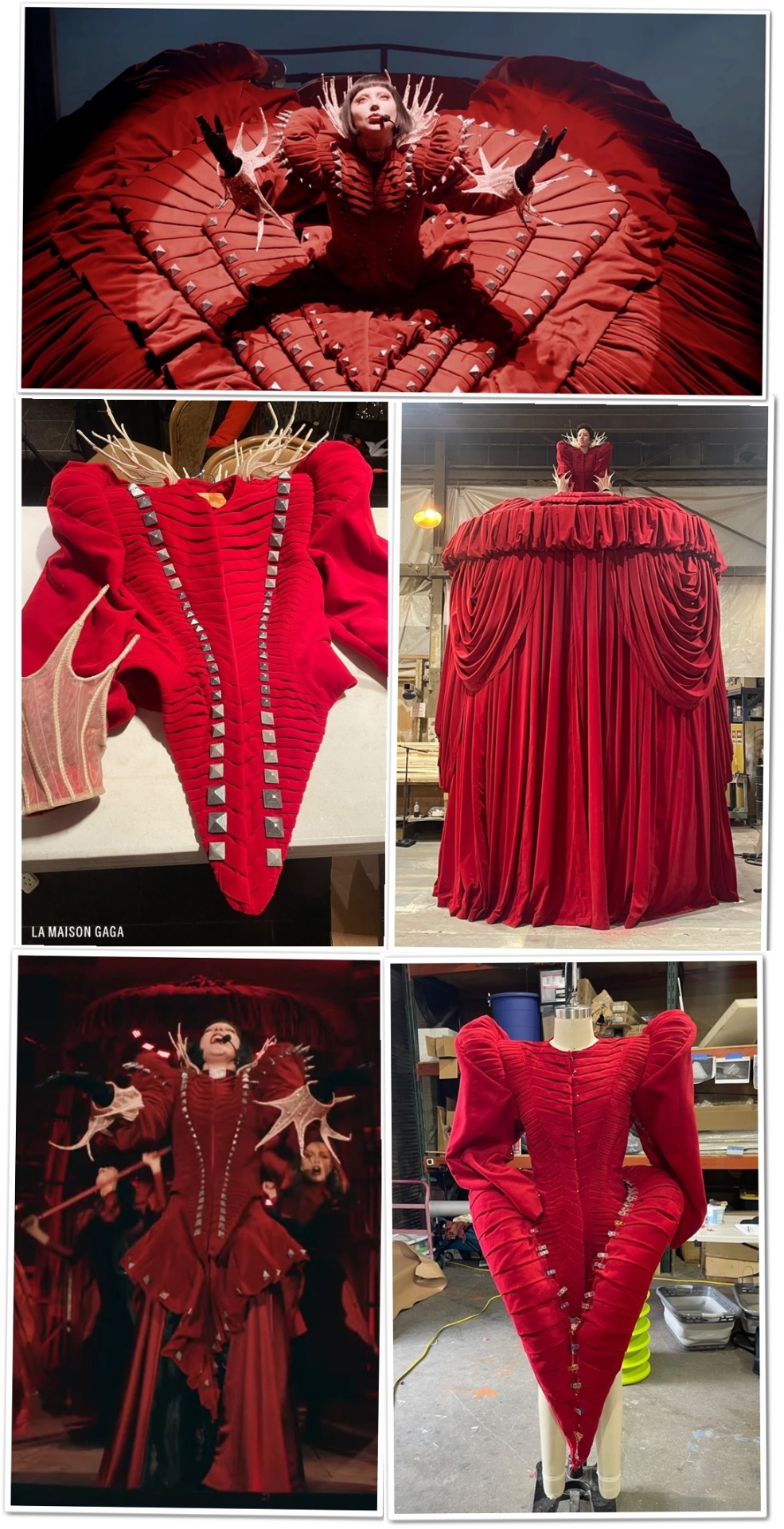
The look? A custom creation by avant-garde visionaries Samuel Lewis, Athena Lawton and William Ramseur—a pleated, studded spiked masterwork of red velvet drama. Drawing inspiration from Edwardian silhouettes and Mugler’s villainous couture—particularly his take on "Lady Macbeth"—the jacket was armored in silver pyramidal studs, its spine and shoulders flaring like a queen prepared for battle.
Beneath the sweeping opera curtain–inspired skirt—engineered by the theatrical masterminds at Jet Sets —hid an elaborate cage several feet tall, housing Gaga’s dancers like a twisted chorus of shadows. The garment was both fortress and stage, its hem draping downward like blood-soaked drapery from an abandoned palace.
Topped with bone-like protrusions with crystal embellishments at the collar and sleeves, Gaga became something between a saint and a specter. Her performance from this fortress-skirted throne was a visual aria: high camp meets high art, rooted in madness, resurrection, and pure spectacle.
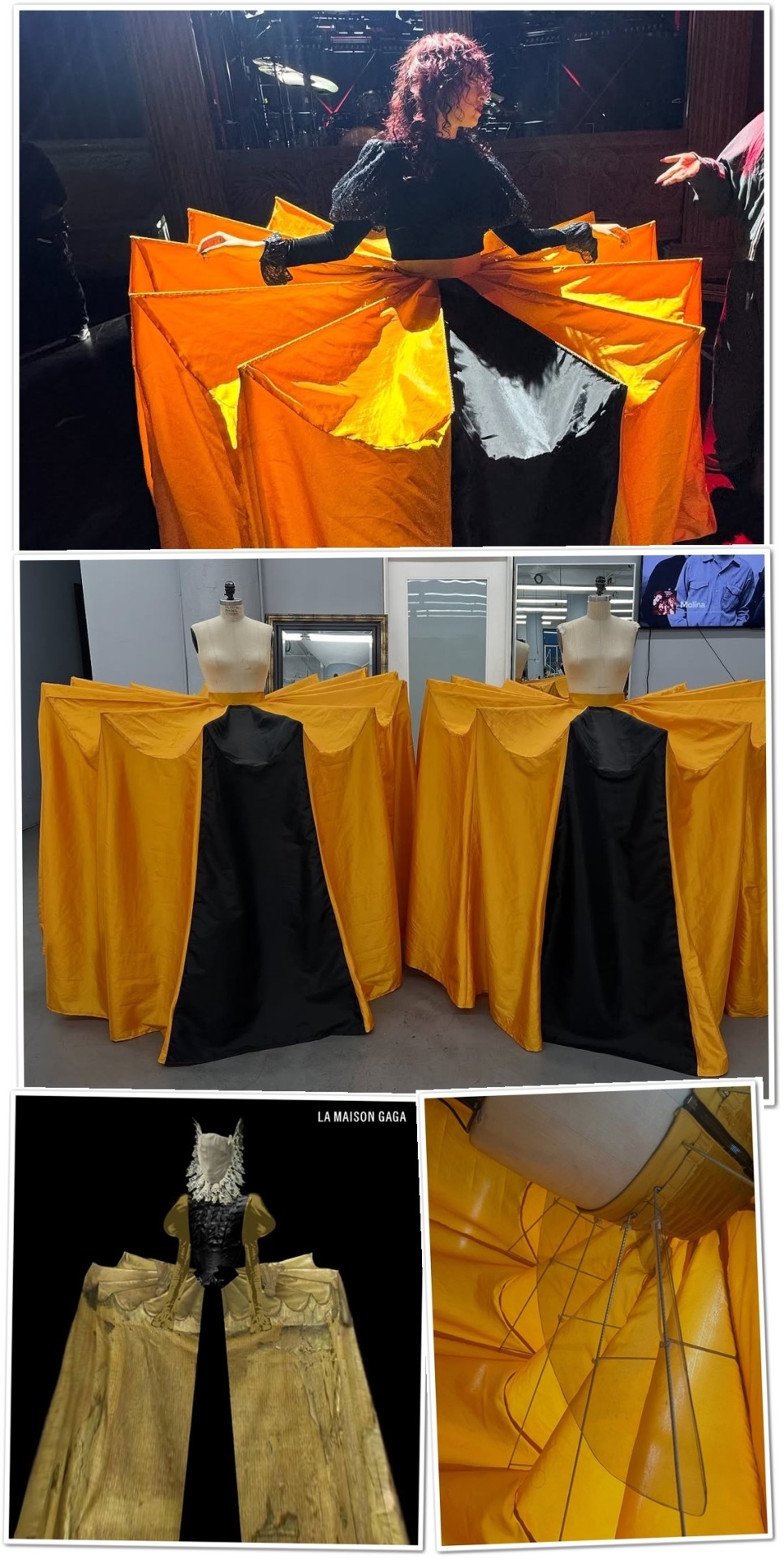
The opera singers beside her were dressed in huge wavy constructed yellow and black skirts with beaded velvet tops, custom-made by Candice Cuoco.
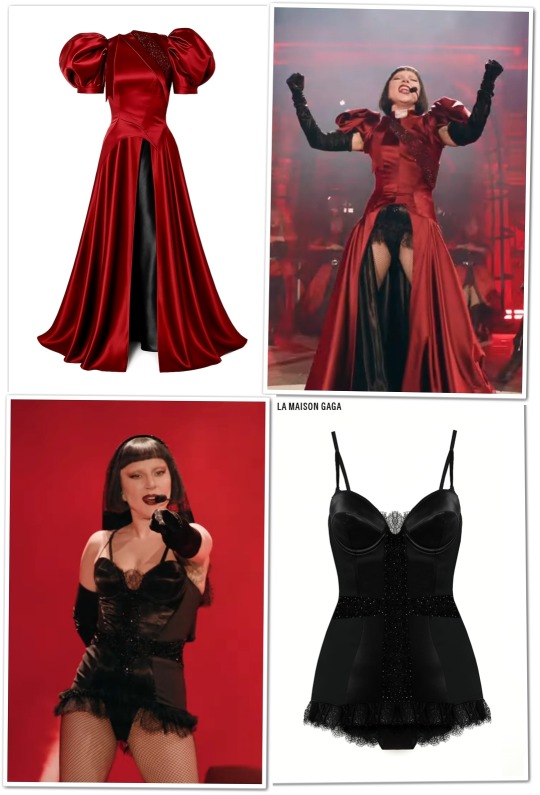
In one swift motion, she shed the heavy opera curtain—only to unveil a sensual, custom-made Samuel Lewis and Seth Pratt creation beneath. The ruby-red satin dress featured a sharp bodice with architectural puff shoulders and a plunging open front that gave way to the black lining. A crystal-embellished sash draped diagonally across her chest.
For the most intimate and arresting act of her set, Gaga appeared in a teddy—part lingerie fantasy, part gothic confessional, custom-made by the same duo. Crafted in rich black satin, the piece featured a sculpted bustier, delicate lace trim, and a shimmering crystal-embellished cross that ran from neckline to hem, catching the light like a whispered scandal.

Gaga strutted across the stage in the surprisingly affordable Leza over-the-knee boots by Steve Madden—retailing for just $89.99. Yes, you read that right.

"OFF WITH HER HEAD!"
Three of the characters are wearing these impeccable black veiled headpieces and dresses which were created by Nasir Mazhar in 2021, originally for balletLORENT.

Gaga's string orchestra wore draped black taffeta gowns made by AGRO STUDIO with custom headpieces all created by Lara Jensen.

As the lights dimmed and the stage transformed into a sepia-toned wasteland, re-emerged not as a pop powerhouse, but as a ghostly relic of beauty undone. Lying among skeletal remains and grains of dust, she conjured a scene straight from a tragic gothic fable.
For this act, titled “And She Fell Into A Gothic Dream,” Gaga wore a custom Dilara Findikoglu corset mini dress—a distressed, doll-like creation that whispered of innocence lost and romance decomposed. The off-white, almost bone-colored garment featured delicately frayed edges, an asymmetric hem, and panels of antique lace that seemed stitched together by time itself. Every rip and raw edge told a story of longing, survival, and sorrow.
The dancers wore skeleton masks made specially by Sarah Sitkin!
Gaga stepped back into one of her most iconic songs—"Paparazzi"—but this time, she didn’t just revisit it. She rearmed it.
As the familiar opening notes rang through the desert sky, Gaga reappeared in a custom Manuel Albarran armor bolero and matching helmet—a direct visual homage to the Mugler look she wore in the original "Paparazzi" music video.
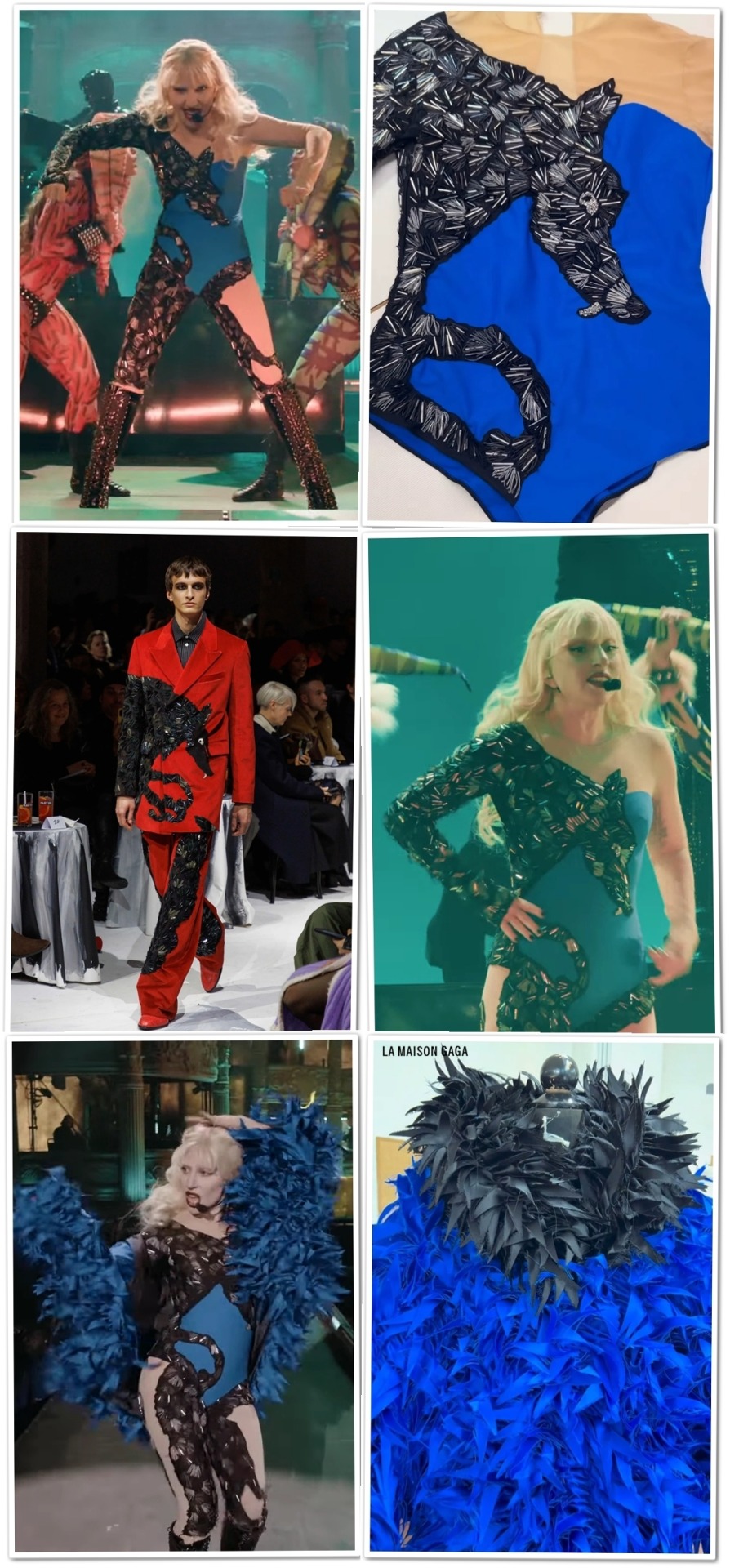
For the high-octane performance featuring Gesaffelstein, Gaga slipped into a custom Marni catsuit, based on the house’s Fall/Winter 2025 collection. The original red suit—featuring beaded embroidery of a black wolf—was reimagined for Gaga as a skin-tight, asymmetrical bodysuit, fused with nude illusion mesh and stitched with jet-black sequins that glinted like sharpened claws.
To elevate the glam rock look even further, Gaga threw on a custom coat made entirely of hand-cut blue and black paper feathers, inspired by the brand’s Spring/Summer 2025 collection.

A true blast from the past are her Savannah vinyl corset boots from Penthouse.

Her female background dances all wore custom costumes by Courtney McWilliams paired with the Miista Imogen black lace-up sneaker boots!
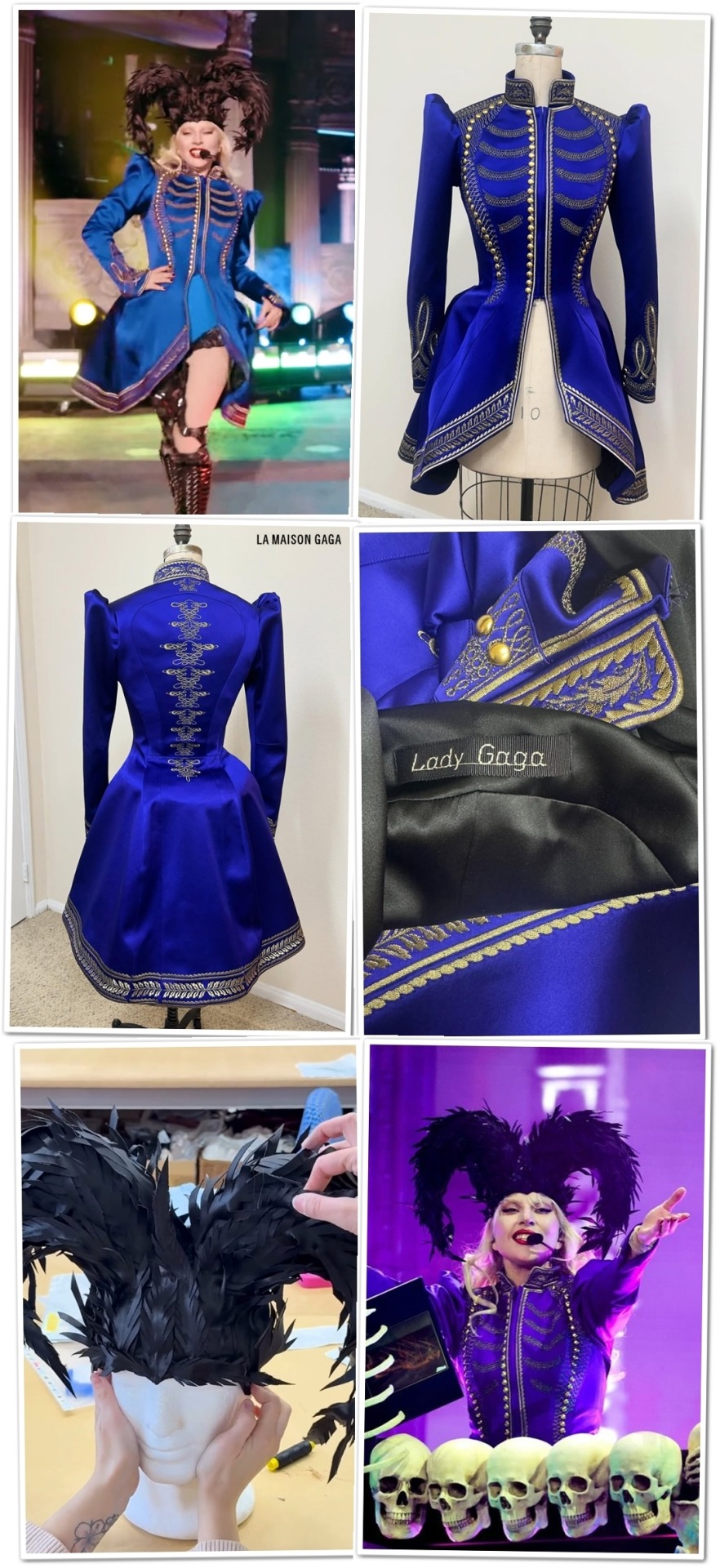
As the opening of "Zombieboy" echoed, Gaga returned to the stage, wearing a striking custom look designed by Samuel Lewis and William Ramseur: a military-inspired royal blue satin bustle coat, tailored to perfection and cut with razor-sharp precision. The garment featured exaggerated puffed shoulders, a nipped waist, and a flared skirt with an almost theatrical silhouette, marrying 18th-century regency with gothic fantasy. The pièce de résistance? The coat’s intricate gold embroidery, stitched by the artisans of Altesa Embroidery, which shimmered like bone filigree under the stage lights—mirroring a skeletal ribcage and spine that gave the look both regality and decay.

But Gaga didn’t stop there. To crown the ensemble, she donned a custom Marni paper feather helmet, styled like a twisted jester’s crown with raven-black plumage erupting from her temples.

The studded harness belt, she wore during "Zombieboy", was custom-made by Jonathan Burdine in collaboration with Iggy Soliven.
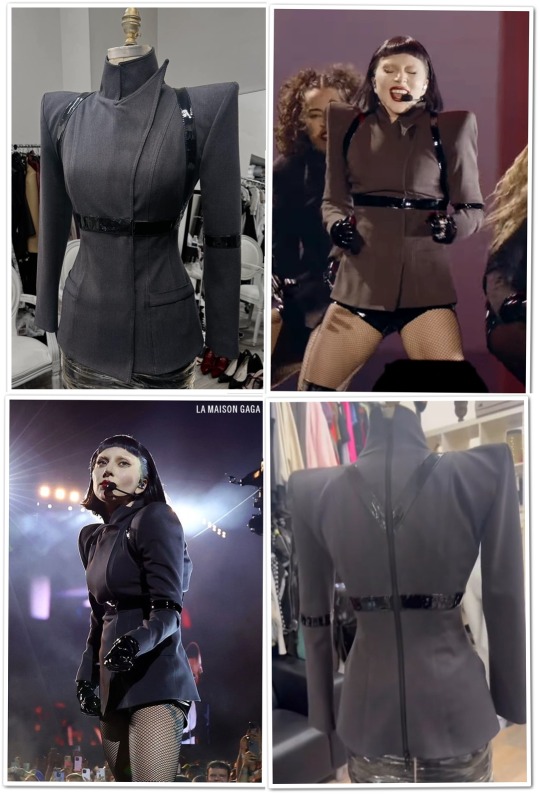
For "Shadow of a Man", Gaga emerged cloaked in mystery and command, donning a custom Louis Verdad x Samuel Lewis creation that was equal parts military regalia and avant-garde sculpture.
The charcoal grey structured jacket, tailored to her frame like armor, featured razor-sharp lines and a high, asymmetrical collar that framed her silhouette like a shadow in motion. Bold black patent leather straps slashed across her shoulders and waist, adding a sense of futuristic restraint to the otherwise regal tailoring.
Underneath, she wore black stretch vinyl shorts by Los Angeles Apparel.

For the final look of the night, Gaga delivered a breathtaking visual transformation in a total couture creation by Matières Fécales (formerly known as Fecal Matter), a brand famed for its futuristic, grotesque, and avant-garde sensibilities.
The custom ensemble was a full conceptual look, comprised of a satin-stitched bodysuit featuring a haunting red anatomical cross motif—meant to evoke the feeling of surgical stitches, resurrection, and rebirth (and a nod to the "Abracadabra" music video!). The bodysuit alone was a spectacle, but Gaga layered it with even more drama: a translucent organza coat (cropped specifically for her performance), and an exaggerated feathered bustle skirt constructed from delicate white plumes that moved with every beat, adding an ethereal weightlessness to the performance.
The silhouette was further intensified with a sculptural feather collar piece—a headpiece of long, otherworldly white feathers shooting upward like wings, perfectly framing her head and extending the theatrical effect, created by Paul Battenberg-Cartwright.

On her hands, Gaga wore elongated gauze gloves created by artist Yaz XL, designed to resemble haunting, claw-like monster hands. The exaggerated fingers extended dramatically into crystal-embellished tips, catching the stage lights with every movement and adding an eerie elegance to her already ethereal silhouette.

To complete the look, she grounded the ensemble with custom white lace-up ankle boots by Chrome Hearts.

The dancers were all dressed in custom Luis de Javier white lace looks and Balenciaga Cagole white boots! The nurses, that wheeled Gaga in, wore custom ILONA red gowns and hats.
#April 2025#Matières Fécales#Louis Verdad#Los Angeles Apparel#Samuel Lewis#ILONA#Seth Pratt#Luis de Javier#Yaz XL#Candice Cuoco#Marni#Manuel Albarran#Dilara Findikoglu#Steve Madden#Lara Jensen#Dolce Gabbana#Chrome Hearts#Balenciaga#Ellie#Nasir Mazhar#Athena Lawton#William Ramseur#AGRO STUDIO#Iggy Soliven#Jonathan Burdine#Courtney McWilliams#Sarah Sitkin#Miista#Gyouree Kim#Paul Battenberg Cartwright
173 notes
·
View notes
Text



Early watercolor sketch from “The Wrath of Canasta” episode of “Duck Dodgers” 2003, with the Cadet and Dodgers enjoying a relaxing vacation in an old west setting, complete with malfunctioning robots. Porky’s costume riffs on Hoss Cartwright, while Daffy heroes-it-up, inspired by the Lone Ranger.
#Spike Brandt#Tony Cervone#Paul Dini#Tom Minton#Chuck Jones#Mike Maltese#Looney Tunes#Merrie Melodies#WB#Warner Bros Studios#Duck Dodgers#Eager Young Space Cadet#Daffy Duck#Porky Pig#Joe Alaskey#Bob Bergen#Westworld#Bonanza#The Lone Ranger#Hoss Cartwright
62 notes
·
View notes
Text
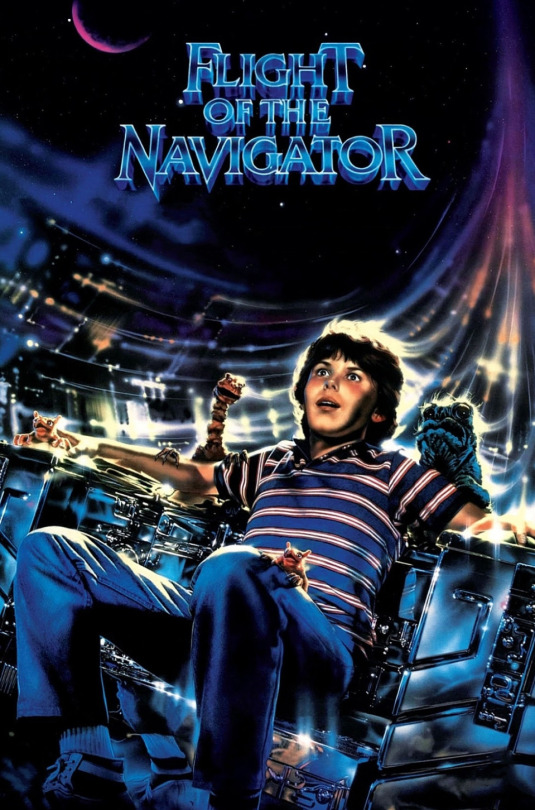
#movies#polls#flight of the navigator#80s movies#randal kleiser#joey kramer#paul reubens#veronica cartwright#requested#have you seen this movie poll
151 notes
·
View notes
Text
𝐑𝐮𝐠𝐫𝐚𝐭𝐬: 𝐀𝐥𝐥 𝐆𝐫𝐨𝐰𝐧 𝐔𝐩! 𝐩𝐫𝐞𝐦𝐢𝐞𝐫𝐞𝐝 𝟐𝟐 𝐲𝐞𝐚𝐫𝐬 𝐚𝐠𝐨 𝐭𝐨𝐝𝐚𝐲 𝐨𝐧 𝐍𝐢𝐜𝐤𝐞𝐥𝐨𝐝𝐞𝐨𝐧!!
#All Grown Up#Rugrats#Nickelodeon#Arlene Klasky#Gábor Csupó#Paul Germain#Kate Boutilier#Eryk Casemiro#Monica Piper#Shelia M. Anthony#Scott Gray#Erin Ehrlich#Peter Hunziker#Joe Purdy#Andrei Svislotski#Zhenia Delioussine#Ron Noble#Jim Duffy#Louie del Carmen#Michael Daedalus Kenny#E. G. Daily#Tara Strong#Nancy Cartwright#Cheryl Chase#Kath Soucie#Cree Summer#Dionne Quan#Mark Mothersbaugh#Bob Mothersbaugh
9 notes
·
View notes
Text
youtube
A refreshing fantasy metal song.
Heard the band (Gloryhammer) for the second time.
After listening to another song from them He Has Returned. (This was the first time.)
Found the songs nice... Fairly clean metal without dark spiritual themes like most other metal bands. (So, I think...)
Surprise surprise! This is a British band!
#Gloryhammer#Fantasy Metal#Clean Positive Metal#Christopher Bowes#Ben Turk#Paul Templing#James Cartwright#Michael Barber#Sozos Michael#Anthony Trimming#Thomas Winkler#British Metal band#Power Metal#Youtube
5 notes
·
View notes
Text
Not enough gay people watched Greek (2007) on ABC Family and that's why there are only 7 Cappie/Evan fics and 7 Cappie/Casey/Evan fics on AO3.
#greek abc#cappie#evan chambers#casey cartwright#captain john paul jones#my comfort trashy tv show#greek 2007
42 notes
·
View notes
Text
Continuing our conversation on fanfic from last week...who'd've thought a series about car crashes would have such a strong connection to that?
Our episode on the 2009 miniseries Collision is available now!
#paul mcgann#girlies for mcgann#collision#also shoutout to photographer john cartwright for the set portraits we're using for this episode's promo stuff
4 notes
·
View notes
Text

Bad movie I have The Simpsons Treehouse of Horror it has Treehouse of Horror V, Treehouse of Horror VI, Treehouse of Horror VII, and Treehouse of Horror XII
#The Simpsons Treehouse of Horror#Dan Castellaneta#Julie Kavner#Nancy Cartwright#Yeardley Smith#Hank Azaria#Harry Shearer#Pamela Hayden#Russi Taylor#James Earl Jones#Marcia Wallace#Doris Grau#Paul Anka#Dennis Bailey#Ron Brooks#Trish Doolan#Marsha Waterbury#Phil Hartman#Pierce Brosnan#Matthew Perry#Tress MacNeille#Karl Wiedergott
5 notes
·
View notes
Text
Jennifer Castle Interview: Recognize My GPS

Photo by Jimmy Limit
BY JORDAN MAINZER
I first came across Canadian singer-songwriter Jennifer Castle ten years ago, upon the release of her fourth album Pink City. Enraptured by its lush arrangements, I caught her live at the Hideout later that fall, only to watch her play the record front to back, with no breaks in between, on solely acoustic guitar, putting its awe-filled lyrics front and center. Ever since then, I've realized Castle is an artist who can do it all--she'd follow up Pink City with 2018's grief-stricken, expansive Angels of Death and 2020's unvarnished, semi-improvised folk record Monarch Season. And whenever she comes out with an album, it seems like it comes just when you need it, at the right time of year to boot. Alas, earlier this month, Castle dropped Camelot (Paradise of Bachelors), another autumn opus that finds something celestial in the earthbound.
On Camelot, Castle culls from the best qualities of her previous records. Unsurprisingly, it returns many of the same personnel, like members of her venerable backing band: guitarist Jeff McMurrich, who co-produced it, as well as drummer Evan Cartwright, bassist Mike Smith, guitarist Paul Mortimer, and vocalists Victoria Cheong and Isla Craig. Jonathan Adjemian, who played piano and organ on Angels of Death, bolsters the choogling mid-album highlight "Mary Miracle" and sweeping ballad "Fractal Canyon". Legendary composer Owen Pallett, who provided string arrangements to much of Pink City, does the same for dramatic ballad "Blowing Kisses", a song that, prior to Camelot's release, appeared in an episode of the third season of The Bear. In a sense, Camelot could be a good entry record for those unfamiliar with Castle's albums and performances. It's got a gentle guitar waltz ("Trust") and solo performance ("Earthsong") as well as expressive, upbeat folk songs (the title track, "Louis").
Yet, Camelot simply sounds bigger than Castle's prior music. That's partly attributable to her looser control of the band. For the first time, Castle played only acoustic guitar on the record, giving control of the piano and keys to Carl Didur. The band's mission to unlock the rhythms of the songs, like puzzles waiting to be solved, eventually sees them play up their 70's rock and country influences. "Lucky #8" finds something holy in dance. Backed by slide guitar from none other than Cass McCombs, Castle sings, “So just give the money to the dancers / While their hips go figure eight / And they entrance us with the answers / And we hope and pray the message ain’t too late.” "Full Moon in Leo", meanwhile, juxtaposes a psychedelic keyboard groove with saxophone from in-demand multi-instrumentalist Stuart Bogie, a strutting country tune with a hazy, flower power AM radio edge. It's one of a few times on the album where the song is self-aware. "I did not come here to talk about orange / And all of the things that have come up before us / And Florida and that warm catchy chorus," Castle sings, her free association-style rhyming giving you a front row to her state of mind. The song is a mix of absurd substance and style: At one point, Castle actually sings, "Big hair, don't care."
What's best about Camelot, though, is Castle's mere control of language. For one, she can write tongue twisters that make your ears itch. On "Earthsong", she sings, "Names are small, and names are games / And forces gain good ground / When light moves tat the speed of sound." On "Blowing Kisses", she declares, "I'm not a beggar to language any longer," and later follows it up with a well-timed obscenity that's a humblebrag statement of conquering: "I'm so fucking honored." On "Fractal Canyon", she sprinkles details of people who sound so mythical they have to be real. "I'm with Paul, who's speaking in an Irish accent / Him and I wear tiger eye, and that's no accident / I take comfort in the stripe, the stone of protection / From Daffodil Bill and the thrill of rejection." Whether or not you know who these people are, it's the line repeated over the song's verses that matters most: "I'm not alone here." In the world of music--from her backing band to the characters in her songs--the writer who often performs on stage by herself is anything but solitary.
I spoke to Castle last month over Zoom about how Camelot fits in within her discography, her writing and recording process, capturing negative human emotions, and stripping down her songs for stage. Read our conversation below, edited for length and clarity.

Jesse Harris' Camelot cover art
Since I Left You: The themes on Camelot alternate between the very real and tangible and the more cosmic and abstract. Can you talk about that interplay?
Jennifer Castle: I wonder if that interplay is always present with my songwriting, which tends to feel like an opportunity to travel great distances while, at the same time, tipping your cap to exactly where you are. In writing, it feels very beneficial for me to recognize my GPS, where I am at the moment, whether that's details, something very literal, or something very grounding that I can mention, I can take to ground the concepts, which often tend to try to transcend where I am at the time. I think both distances, the small, minute place, and the large, vast, potentially infinite spaces, are interesting to try to map out when I'm making a record.
SILY: I see that in all of your songs, but it did stand out to me on this record.
JC: I think you're right. There were definitely times when I was recording where I was trying to address larger orbits, larger spheres.
SILY: I might be a little bit taken by the sound of it, too, because your previous record was comparatively minimally arranged. What inspired your decision to make this a much fuller sounding record with a band?
JC: I think Monarch Season was more of a definitive decision than Camelot was. It's challenging for me to be as consistent in vibe as Monarch Season was. I [wanted] to make a record where I set a tone and [continued] that tone all the way throughout. I tour a lot solo because it's accessible, and people afterwards would come to me and say, "What record is like what you just did?" And I'd say, "I don't actually have one." I was always describing my records, saying, "Pink City has these arrangements," and "Angels of Death has a band," so I really made a decision to make Monarch Season the way it was. Camelot returns back to a natural musical sensibility where I like all different types of songs.
Monarch Season also came out right as the pandemic happened. I had made it while I was really busy touring. I stole away a weekend in 2019. It was released at a time when some people were in really still, quiet places, at home. It was seen as something bare and minimal, and collectively, we were going through something that was more essential or quiet. While I was going through those years, I was back to imagining all those great spaces I can take up. I envisioned the Camelot songs sounding the way they did before we even made them.
SILY: Some songs on Camelot do lend themselves to the way you play live, but others I'd be interested to see how you bring down to something more stark. Did you write the songs on guitar before fleshing them out?
JC: More or less. Maybe "Blowing Kisses" I wrote on piano. I think that might be it on this record. I just played acoustic guitar in my kitchen. My son was home a lot--he wasn't in school at the time--so I wrote them at home with my little life happening around me. I have distinctive memories of, not writing in lyric, but strumming out "Mary Miracle" and thinking, "What a funny tune!" It has a propulsion to it. I could already hear it. It's almost like it was already there and I was waiting to get to go and record it.
SILY: That's funny--I wrote down "propulsive" a lot when listening to this record. I love on "Mary Miracle" how you're ranting and you don't finish your sentence before you go back into the chorus: “And I want to know how you came to value / The practice of dragging by the hair those pals who / On their invisible crosses / Of their capitalist bosses / Who in the trash tossed out / That red beating thought that / That all is not lost and / That belief at all cost and...”
JC: I felt this record had a little bit of a breathlessness to it in general. It felt lyrically exhaustive. I don't mean that as a diss to myself, but it had a run-on-sentence aspect to it. Monarch Season, the songs were more lyrically refined or even taking a page from haiku. This one felt like the narrative always could have had one more thing to say. That even presented itself in the recordings and performances. They're wordy.
SILY: Were there any newfound aesthetic or instrumental influences on Camelot?
JC: I certainly have never just played acoustic guitar all throughout a record before. I gave the majority of the piano and keys to Carl Didur, and the rest to Jonathan Adjemian, who does the run on "Mary Miracle". I sat back and let us perform as a band ensemble. I hadn't done that consistently throughout a record before. I often perform bed tracks and build them, and maybe a handful of songs we'll do together, or there's more of a balance between built bed tracks and recording. Other than the two spare guitar songs that I play, [on Camelot,] we went in together. It has a cool ensemble feel, which I love, and I'd like to learn more about how to do that and trust that process.
SILY: That makes a lot of sense. For instance, I had never heard a song of yours ever quite like "Lucky #8" or "Full Moon in Leo", that give jangle pop and Dolly Parton/Emmylou Harris vibes, respectively.
JC: I don't know all of everybody's songs or catalogs, but I've gotten their downloads. I know the energy. Often, people are more taken back live when I share that, but I can embody the energy really easily. I don't know that I had necessarily put it on record before. Even "Sparta" on Pink City was built up from a really spare bed track. Songs that are more rock songs that I've made were more architecturally built. "Lucky" has flourishes, but we got it as a band together. Same with "Full Moon in Leo".
SILY: Even the songs you recorded as a band together have an aspect of restraint that's reminiscent of some of your earlier work: the calmness of the title track, the way "Louis" is built around the bass line.
JC: I always have a fairly funny joke with the people I'm recording with: I don't mean it literally, but I always say we're in a crew. It's kind of like Lord of the Rings. We all have to hunker down together, we all have to find the groove, and not many people get to have fun. Then, there'll be a moment where the bass gets to go for a tour, or maybe we hear something from the guitar player. There's lots of rock music where everybody is doing tons of stuff. If we're going to be together, I like us to hunker in together and hit the groove. That's more of a style I think I have.
SILY: I wanted to ask you about the following lines on "Trust": “Scientists insinuate / That facts are facts and lines are straight / Doctors say they can help / Then stoke you with the fear of death," and, “Church is good / church is great.” Are you bouncing back and forth in tone on those lines? Are you at all being facetious? From what perspective are you singing?
JC: I think that song was the last song we recorded. The band had never heard it. It wasn't even really a song before we recorded it, but I had a hunch it was maybe a song. That song starts with really basic human negative emotions we're all prone to and then scales it out to places where people are in a position of power. The way I think about it, you have the church, then the medical fields and science, then government. [The song] keeps going for places where power is played up. I think it's interesting that it at first links it to these basic human emotions we all feel. I didn't have something I was trying to get across in that song. I had a hunch it would be interesting to include something more paranoid and uneasy with this collection of songs, even though I wasn't quite sure how it would fit in. I thought that was kind of cool, in a resonant way.
I learn a lot about that song when I listen to it, too. I still have things to learn about it. I don't know where it's necessarily entirely coming from, or what it means. But I don't think it has a particular meaning. What I've gleaned is that what starts out in our tiny resonant selves can escalate. You can be in a massive position of power and just work from core human emotions, and those are the negative ones: cynicism, jealousy, anger. I'm not saying they're not good or that I've never felt them. I'm just saying they're there and they run through us. How do those work? At what place do they stop being within the cages of our own being, and more into what we think of as social and collective?
SILY: "Trust" fittingly comes after "Some Friends", a song that deals with the complexities of friendship and interpersonal relationships. I feel like "Trust" is like "Some Friends", but amplified.
JC: ["Some Friends"] has betrayal right up front. Sometimes, I like to get the tough stuff out at the front of the record. I remember when I was sequencing Pink City, I was like, "We have to have 'Working For The Man' and 'Nature' up front." People were saying, "Put 'Sailing Away' up front!" and I said, "No, no, no, we gotta...introduce the spectrum of feelings that might be on the record." There are hurt feelings on "Some Friends". I hadn't really explored that too much. I don't think it's bitter, I think it's more hurt. When you're a writer, you can turn a phrase really quickly and cast it off as being bitter or cynical. I've done that a million times and probably still will. I like sharp wit. But I thought there was something sitting a little more complicated in those first couple songs.
SILY: On "Lucky #8", when you sing, “And I don’t want to lose ya / You’re my only audience / Nor will I abuse ya / By not making sense,” are you breaking the fourth wall and making a comment about obtuseness in songwriting?
JC: [laughs] I like the idea of breaking the fourth wall. It's another thing that would fall under the GPS context, making it suddenly very clear where your position is and where you're at, at the very moment. "Suddenly, I'm singing, and I'm looking directly at the audience." That song is an absolute run-on sentence to me. By the time I get to that place, there is a part of me saying, "Don't turn away yet, I'm trying to get somewhere." At the same time, I think there's me, the human, that wants to communicate so much, and me, as an actual person, I really struggle to communicate. I'm probably really obtuse on a good day when I'm in my kitchen. So I try to communicate really clearly in song, but at the same time, I believe song is like an abstract art. I like abstraction. I've even thought about that line but then thought, "Don't go out of your way to make too much sense if it doesn't serve the moment." Allow things to kind of be multi-faceted or have lots of ambiguity in them. I like that [songwriting is] an abstract art. I want [my songs] to live in spaces that aren't mine and minds and hearts that aren't mine, so I have to cherish abstraction on some level. I have that in common with a lot of people, that it's hard to communicate from our deepest wells of what we think and feel. As a writer, I stab away at it.
SILY: I also wanted to ask you about the album art. If I had heard the record first, or picked up the record in a store based on the art and listened later, I'd feel there was a definite contrast between the starkness of it and the lushness of the record. Was that an intentional contrast?
JC: I gave it all to Jesse Harris, a Toronto artist I admire. He has a severity to him. It's like he's carrying a sword. He cuts away everything in his artwork that doesn't need to be there. There's a very severe austerity to his work, and he's deeply funny. I offered him an opportunity to design the record. Lyrically and sonically, it's really detailed and rich, so I sent him the link to the record, and it wasn't too long until he sent me back the door. I was like, "Oh my god, what does it mean?" and then thought, "Okay, yeah, the door, I love it." [The cover] could have been baroque or a whole visual world to match. In that simple gesture, I think we got to go through the door, and from there, it unfolded. I don't want to speak for him, but I remember in the early days when we were designing it, he saw Camelot as a land he was referencing, like on an old board game like Snakes and Ladders, where you never know where you're ending up, where you can fall down and lose everything, or you can keep climbing and get somewhere. He saw it as a hard place to navigate and wanted to convey that, not to make linear sense of it but to know that there's a journey, or that somewhere, someone's trying to get somewhere. I love the door now. I think it's iconic for this particular record. It's so simple.
SILY: Have you performed these songs live?
JC: I'm just starting to. I performed "Lucky #8" a few times a few years ago when I was on tour with Godspeed You! Black Emperor, as well as "Louis". That's when Jeff McMurrich, who co-produced the record with me, heard them, and asked, "What are those run-on sentence songs you were singing?" [laughs] But I haven't played that many shows. I played "Trust" for the first time last week when I was in Halifax. I hadn't ever played it save for when we recorded it. I just started to play "Fractal Canyon". I've never played "Mary Miracle". They're just starting to come around now.
SILY: Is it just as rewarding as an artistic endeavor to bring the songs back down to their bare elements for an audience, as it was to make them in the first place?
JC: Yeah, it's kind of cool to start to get to know them. I've never played "Full Moon in Leo". I think a band is going to start to rehearse for some shows. That will be cool to hear them with a rhythm section and the vocalists. Me playing them solo is tender. It reminds me of where I was when I wrote them, which can be a really weird element of time-travel.
SILY: It puts you in the same headspace as their original inception. Does that help you connect more with the audience?
JC: I think it does. Catching it on these early incarnations is cool for the audience. You're really hearing something more becoming even if it has a recorded version. Years from now, I'll have played "Full Moon in Leo" dozens of dozens of times, and I'm sure it'll be great, but it'll be really cool to hear these songs start to come to life.
SILY: Are you planning on coming to Chicago?
JC: I'd love to! I'd love to come to the States. The UK is popping up, and Canada is popping up, but it's challenging with the visas to get over to the States. I have to trust, and if people want me to come, I always like to go. It just takes a couple of people, a festival or a promoter reaching out, and I can start to piece it together. But I don't have anything planned. It's challenging I can't just pop over [to Detroit]. I had to say no to a couple shows a couple weeks ago because they would have put me in that region. But it was last-minute, and these visas are very expensive. They take quite a long time to process, months and months. Hopefully, in 2025, I'll come to the States. It would seem weird not to. We are neighbors. [laughs]
SILY: Is there anything else next in the short or long-term for you?
JC: I'm just gonna be trying to get these [songs] up and running to tour. I have a couple shows coming up for the Winter Solstice I play every year. In terms of writing, just a little bit. I'm not taking a break, but I'm focusing more on how to present this music.
SILY: Is there anything you've been listening to, watching, or reading that's caught your attention or inspired you?
JC: I'm sure there has, but I can't really think of it right now. I'm mostly just getting outside and walking around. But I love my friends and the music they make.
Tour dates
12/20: Tranzac Club, Toronto, ON
12/21: Tranzac Club, Toronto, ON
1/22: The Artesian, Regina, SK
1/23: Handsome Daughter, Winnipeg, MB
1/24: TBD, Saskatoon, SK
1/25: CKUA Radio Performance Hall, Edmonton, AB
1/26: The Palomino, Calgary, AB
2/13: The Globe, Cardiff, UK*
2/14: St Luke’s Church at Queens Park, Brighton, UK*
2/15: EartH, London, UK*
2/16: Hare & Hounds, Birmingham, UK*
2/17: St Mary’s Creative Space, Chester, UK*
*with Jake Xerxes Fussell
youtube
#interviews#live picks#jennifer castle#paradise of bachelors#owen pallett#jesse harris#tranzac club#the handsome daughter#ckua radio performance hall#the palomino#the globe#st luke's church at queens park#earth#hare & hounds#camelot#jimmy limit#pink city#angels of death#monarch season#jeff mcmurrich#evan cartwright#mike smith#paul mortimer#victoria cheong#isla craig#jonathan adjemian#the bear#carl didur#cass mccombs#stuart bogie
1 note
·
View note
Photo
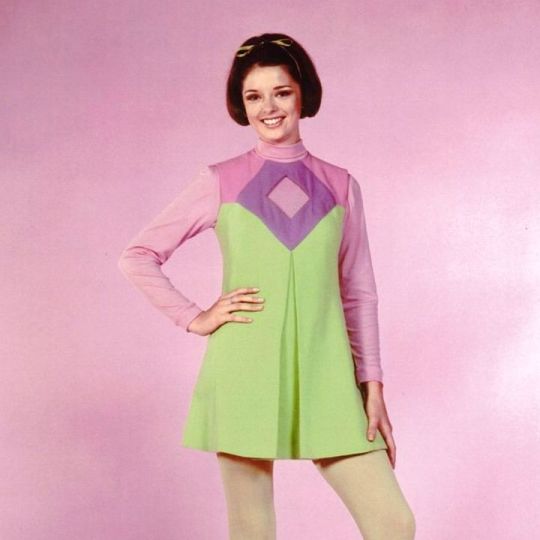

This distinctive and colorful mod-style dress was created for the 1965 third season of 𝑳𝒐𝒔𝒕 𝒊𝒏 𝑺𝒑𝒂𝒄𝒆, where Angela Cartwright wore it as Penny Robinson. Costumes for the series were designed by the art director Paul Zastupnevich, and executed by @westerncostumecompany In a 𝑺𝒕𝒂𝒓𝒍𝒐𝒈 interview, Paul Zastupnevich said: "...I wanted each individual to have their own color, so you could instantly tell who they were from a distance. I tailored the hues to the characters because certain colors make you feel good, while others make you feel threatened.” Zastupnevich even had spacey names for the colors he chose, such as “meteor red,” “comet green,” “solar yellow,” “asteroid green,” “orbital purple,” and “jet pink.” Most of the colorful costumes from the show have made their way to auction and are now in the hands of private collectors. This piece, however, was likely to have still been hanging on a rack at a costume house because it was pulled for use on Cailee Spaeny as Priscilla Presley in the 2023 film Priscilla. Find out more on our website! bit.ly/PostEd261
#AngelaCartwright#Priscilla#CaileeSpaeny#PaulZastupnevich#CostumeDesign#VintageFashion#CostumeAuction#FilmFashion#FilmHistory#ThrowbackFashion#SciFiFashion#Costumes#RecycledMovieCostumes
269 notes
·
View notes
Text
The main/significant Incredibros students as IB sprites!
had a lotta fun with this one :D
Also yes, pretty much every version and a mod I like has an Incredibros conterpart-

Viktor Don Pierre - IB counterpart of the Alpha Polos
Vincent Elliott Pierre - IB counterpart of the Original Polos
Wilhelm Cry - IB counterpart of Cry from The Love
'Chillin' Charlie Johnson - IB counterpart of Chillin from the Love
Simon Philly - IB counterpart of Siffle from Little Miss
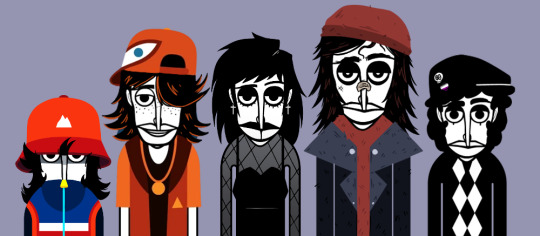
El Cool P (Paul Elias Cooper) - IB counterpart of El Cool P from Wekiddy
Harry Goodman - IB counterpart of Hurry from Alive
Lila Joan Berg - IB counterpart of Lilac from Orin Ayo
Xavier Dan Cartwright - IB counterpart of Capitan from Xrun
Wilson Juraji - IB counterpart of Uare from Little Miss

Jacko Nicolas Lynn - IB counterpart of Jacko from Evadare
Timothy Phill - IB counterpart of Teeth from Evadare
Igor Ferdinand - IB counterpart of Infectat from Evadare
Ralph Scott - IB counterpart of Rafe from the Evadare saga
Dylan Tobias Steele - IB counterpart of Choir from Dystopia
#incredibros#incredibox#incredibox fanart#art#fanart#small artist#au#digital art#evadare#wekiddy#alive#orin ayo#original character#little miss#ocs#ref sheet#sprite edit#design#xrun
187 notes
·
View notes
Photo

The Origins of British Pub Names
Pubs remain a prominent feature of the rural and urban landscapes of Britain, but their names very often date back to medieval times. Red lions, white horses, and colourful characters peer from pub signs as landlords choose names to represent local history, legends, landmarks, national figures, or simply imply their drinking establishment has a long and prestigious heritage.
This article presents the meaning behind some of the most common pub names seen across Britain from Penzance to the Hebrides. According to The Wordsworth Dictionary of Pub Names, there were over 50,000 pubs in Britain at the beginning of the 21st century. The same source identifies the top 20 pub names. Red Lion, Crown, and Royal Oak are the top three, then (in alphabetical order) Anchor, Angel, Bell, Bull, Coach & Horses, George, George & Dragon, King's Head, Nelson, New Inn, Plough, Railway, Rose & Crown, Swan, Duke of Wellington, White Hart, and White Horse (269). As the appeal of pubs and inns has widened to other countries, many of the traditional British pub names can be seen today around the world from New York to Melbourne.
English Pub Signs
Mark Cartwright (CC BY-NC-SA)
The pub names below have been selected because they are especially common, their meaning is obscure, or the history behind them is of particular interest. Self-explanatory but, nevertheless, very common names such as Hop & Grape, Jolly Sailors, or Duke of Marlborough are omitted for want of space. As shall be seen, many variations of a name are possible, even in broad meaning, but a local would always have known the precise significance of their pub's name since, from the late Middle Ages until the mid-19th century, when most of the population was illiterate, it was the pub's sign which gave the establishment its name (and not vice-versa, as is usually the case today). Pub signs, which were made obligatory by a 1393 law, can take the form of a painting, a representation in wrought iron, a three-dimensional model, or even a weather-worn example of the object itself.
Anchor
The name Anchor is, naturally, most popular by the coast where fishing traditions are strongest. However, the name was also common for pubs near canals, particularly overnight stops for barges carrying goods such as coal and wine between towns and cities. The name can be qualified by all sorts of adjectives related to seafaring such as Foul Anchor (used to rescue a ship in distress), Sheet Anchor (a ship's largest and most reliable anchor), and Raffled Anchor (an entangled anchor). For extra cachet, the name might be upgraded to Royal Anchor. A lesser-known significance of the name is when it is used in reference to Saint Paul who, in the Bible, mentions that faith is like an anchor and gives hope, hence the pub name Anchor of Hope. As the colour blue is symbolic of hope, pub signs for this name very often depict a blue anchor. Finally, there is the common variation Crown & Anchor, which refers to the arms of the Lord High Admiral and the badge of petty officers in the Royal Navy.
Continue reading...
28 notes
·
View notes
Text
📰🧤Chapter Twelve: The Case of the Precarious Park 🎢🌊

You are cordially invited to: The Press Opening of 22Fun B Baker Merriment Park (and Memorial) August 18th, 1891 That place that used to be the only standing monument to the Anglo-Turkish War (we think)
In which a morbid interruption leads to a potential new case, and all is not as it may seem…
Transcript here and at 224bbaker.com, where you can also find bios, more info, and links to our social media.
Full credits and content notes below the cut
CREDITS
Written and Directed by Ian Geers and Lauren Grace Thompson. Sound designed by Sarah Buchynski. Produced and edited by Lauren Grace Thompson. Original music by Baldemar and Ian Geers.
CAST
Hampton Fawx: Jeremy Thompson
James Stallion: Chris Vizurraga
Madge Stallion: Katie McLean Hainsworth
Archie Cartwright: Shawn Pfautsch
Lucius Peppermint: Evin McQuistion
McMurphy/Bram: Ian Geers
Dr Iphegenia Brown: Hannah McKechnie
Inspector Braddock: Wesley Scott
Inspector Whittle: Jay Donley
Elizabeth Weatherby: Allie Babich
Devlin Montgomery, the Standard: Chris Hainsworth
Tuppence Montgomery, The Times: Sarah Coakley Price
Jacob Sullivan Montgomery, The Spectacle: Trey Plutnicki
Fitzy, The Evening Sun: Zack McKenna
Forensics Paul: Daniel Millhouse
Ambrosius: Llewyn Geers-Thompson
CONTENT NOTES
This episode contains adult language and sexual innuendo. Discussions of murder, blood, dead bodies. Visit to a coroner.
25 notes
·
View notes

